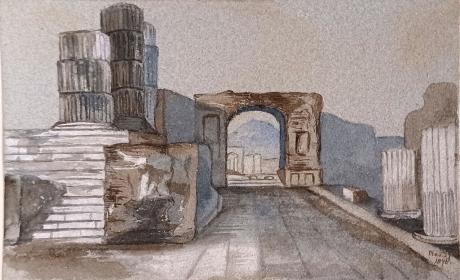inscribed as title and dated " Nov 27 1876"
The Fourm was located at the heart of Pompeii, and was a thriving market and trade centre, and also had many connections to politics. In earlier days of ancient Roman life, the political side of things was restricted to the comitium, which was the northern corner of the Forum. The rest of the area was occupied by the market. Later on, the markets were moved to make way for a larger public meeting space. There was a large variation of those who entered the Forum, as the day went by. Life in the Forum reached it's peak usually during the 11 o'clock hour, which was known as the Roman fifth hour. Various public buildings, such as the Temple of Jupiter, the Temple of Apollo, the Temple of Vespasian and the Basilica face the Forum, and it has a prime view of Mt Vesuvius. The Forum itself was quite large, measuring 157 x 38 metres.
There is a colonnade with Doric columns built around the Forum, and the square was paved with travertine with Ionic columns eventually also adoring the outer edge of the Forum. The Forum, although also used as a market, was especially used as a political centre. There are many buildings there that tell us this. The function of the municipal buildings is still not entirely certain, although it is thought to have served as a meeting room for administrators, or a legal archive or a hall of the decurions. The Comitium was an open air hall that was used as a polling station for public office elections. The Basilica was a building dedicated to administering justice and business negotiations. During election times, candidates would use the temple steps to make their election speeches, and their clients would be expected to come and support them. This conveys the fact that politics was an important aspect of ancient Roman life, and that politicians were rather high up in regards to their social status. It was expected that everyone would respect them, and they were some of the most important people to live in Pompeii. The Forum was also a place where people could take part in religious ceremonies, honouring the Gods who watched over Pompeii.
Many paintings have been discovered that depict the bustling life of the Forum. They show men consulting officials, a family choosing shoes to buy, a school teacher who has a class under the colonnade, and a rich lady giving some spare coins to a beggar with a dog. All of these images show how the ancient Roman life wasn't too unlike life today, especially among the political and economic aspects. The Macellum was the main food market of the Forum, fish being one of the main foods, due to the Mediterranean Sea being on Pompeii's doorstep. It was a circular area with a domed roof, which had a hole in the top. This was possibly to allow the stench of the fish to leave, and this shows the ingenuity of the ancient Romans. There was also a pool in the centre, possibly containing the fish that could be bought.
The Forum, architecturally, was united and functional. All the elements were brought together to portray cultural strength, strong economy and the positivity of the town, in an easily accessible area. The Pompeians used the walls of the buildings surrounding the Forum, namely the Basilica, to write colourful painted notices, and more colour was added into it with the brightly coloured walls and red roofs.
Mary Keightley (1854-1946) was the youngest daughter of Archibald Keightley (1795-1877), executor of Sir Thomas Lawrence’s estate. She was a good amateur artist. Archibald Keightley (1795-1877), who was a solicitor who was the executor for Sir Thomas Lawrence, who had died earlier in 1830. Mr Keightley was responsible for the sale of Sir Thomas's collections, some of which were not paid for! There is a very interesting story about Sir Thomas's collection of old master drawings which were part of the assets Mr Keightley had to dispose of. Following his work as a solicitor, Mr Keightley a few years later became the Registrar for the Charterhouse School, where he remained for 39 years.
Mary Keightley was born in 1854, in Charterhouse, Middlesex, England, United Kingdom, her father, Archibald Keightley, was 58 and her mother, Sarah Elizabeth Yates, was 41. She lived in London, England for about 20 years and Royal Borough of Kensington and Chelsea, London, England, United Kingdom in 1891. She died on 20 April 1946, in Camberley, Surrey, England, United Kingdom, at the age of 93.

